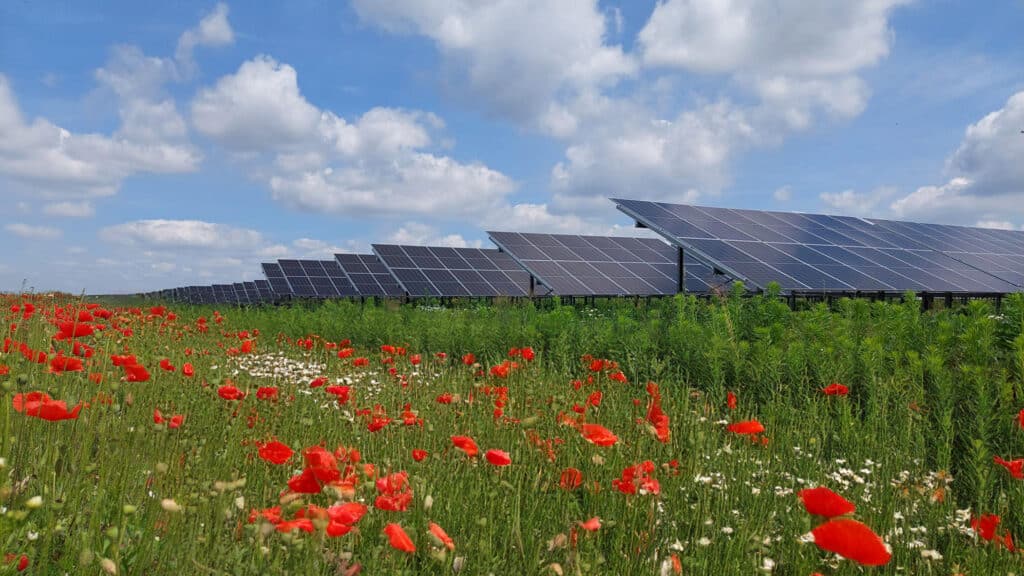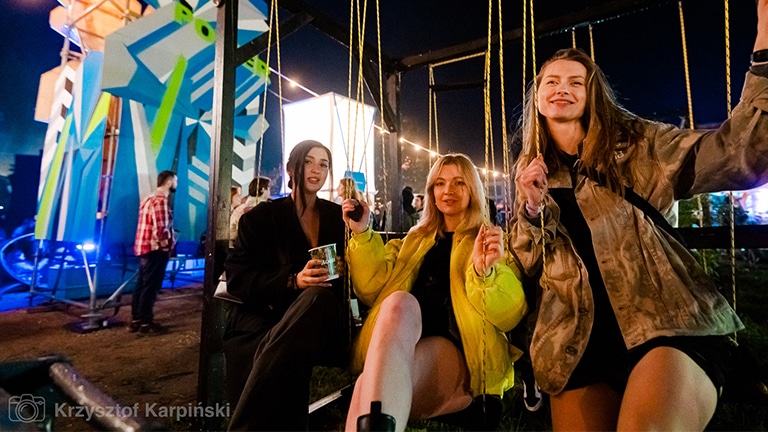Electrum
more than energy
Get to Know Us
Electrum is a leader in Renewable Energy (RES) and Climate Tech. We design and implement clean energy technologies that redefine the future of energy and climate. Together with our partners, we are building a world based on sustainable and innovative energy solutions that protect the environment and support the development of modern societies.
We continuously expand our portfolio with new projects, accelerating the global energy transition megawatt by megawatt.
What We Do?
We specialize in integrating wind energy, solar power, green ammonia, hydrogen, and green heat technologies, creating efficient and eco-friendly energy systems supported by innovative energy management systems and advanced AI tools.
We have built over 3 GW of green power capacity, including 2.5 GW in Poland – accounting for nearly 15% of the total installed capacity in large-scale energy facilities across the country. We currently manage nearly 250 facilities with a total capacity of 2.5 GW.
We Lead the Alternative Energy System
For nearly 30 years, we have been developing comprehensive expertise in technological consulting and design, construction, implementation, monitoring, and optimization of energy systems, tailoring our offerings to the evolving needs of the market.
We create innovative and creative solutions for the digital and sustainable energy of the future. Together with our partners, we are advancing the dynamic alternative energy market – including being a leader in the implementation and maintenance of hybrid facilities.
Partnering with us is a pathway to realizing modern and flexible investments.
Responsibility at Every Stage of Project Development
Our comprehensive services include the preparation and management of facilities and energy processes, power output services and grid integration, energy efficiency optimization, general contracting, and servicing and maintenance of renewable energy facilities.
As a general contractor (eBoP) and provider of EPC/BoP services, we take full responsibility for every stage of project implementation in the field of renewable energy and alternative energy systems, providing our clients with complete support at all levels of their investments.
We Offer Comprehensive Solutions

1,7 GW
from Solar Farms
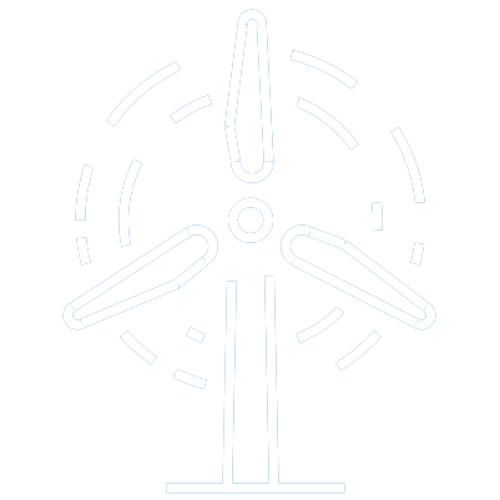
1,4 GW
from Wind Farms
3,5 mln tons
of reduced CO2 emissions
We Offer Comprehensive Solutions

1,7 GW
from Solar Farms

1,4 GW
from Wind Farms

3,5 mln tons
of reduced CO2 emissions
Responsibility at Every Stage of Project Development
Leveraging the expertise of our specialized teams and nearly 30 years of experience across diverse markets, we help our investment partners create efficient, sustainable, and technologically resilient energy projects that address local needs and challenges. Comprehensive renewable energy (RES) implementations are the cornerstone of our operations—we oversee the entire lifecycle of energy assets and are among the first to offer O&M services for large-scale RES facilities.
Our R&D team continuously works on enhancing the quality and technological advancement of our proposed solutions, initiating and participating in international research initiatives. These efforts result in innovative energy management systems that support the development of a sustainable green energy ecosystem.



We Provide Comprehensive Support and Solutions
Energy Storage
Green Hydrogen

Operations
& Maintenance
We Provide Comprehensive Support and Solutions

Energy Storage

Green Hydrogen

Operations
& Maintenance
Hybrid renewable energy systems – An Interview with Kamil Kozicki
Hybrid renewable energy systems are facilities that use more than one source of clean energy generation. These are advanced systems that combine different renewable technologies, such as solar and wind energy, to increase production efficiency. In Poland, due to favorable weather conditions, we most often invest in solar and wind energy.
In the long term, we can expect various combinations of energy sources, such as water-sun or water-wind connections. However, at the moment, the most accessible and efficient solution is a combination of solar and wind energy, which complement each other perfectly, enabling stable energy production throughout the day.
One of the first large-scale hybrid power plant in Poland is the Kleczew Solar & Wind Park.
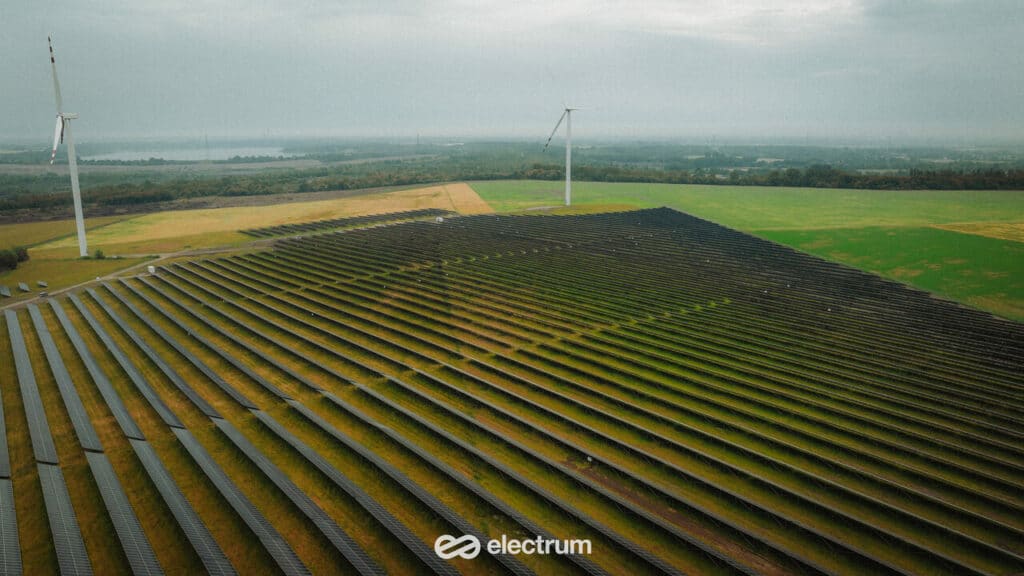
We talk with Kamil Kozicki, an expert from Electrum, about Kleczew and explain how modern hybrid installations contribute to the energy transition. We also discuss the current legal status of such installations and the reasons why investing in them is worthwhile.
How does the Kleczew Solar & Wind Park work?
In Kleczew, we have two integrated energy sources: a photovoltaic (PV) farm and a wind farm. The PV farm has a maximum capacity of 193 MW (AC), with an installed capacity in the PV modules of 250 MWp. This means that the system is oversized by 30%, allowing for stable energy supply even under varying weather conditions. The second facility, the wind farm, consists of four Nordex N133 turbines, each with a capacity of 4.8 MW, totaling 19.2 MW of installed capacity. However, due to connection limitations, we can currently only deliver 11.7 MW of wind power. The connection capacity, or the maximum power we can deliver to the grid based on the connection agreement, is 204 MW for both energy sources combined.
The common point of connection between the PV farm and the wind farm is the Main Offtake Point (GPO). Thanks to the hybrid installation, the energy produced by these farms is transmitted via a single high-voltage cable. This optimizes transmission infrastructure and reduces costs.
How does Kleczew stand out among other hybrid facilities in Poland?
It is the first farm on such a large scale. The first with connection terms issued that explicitly indicate two energy sources in the connection agreement. This means it was clear from the beginning that this is a hybrid facility. Previously, micro-installations combining photovoltaics with a few wind turbines were developed, but here we have a large-scale facility with 250 MWp of solar power and 19.2 MW of wind power (installed capacity). The facility is controlled by Electrum’s proprietary solution, the Renedium master controller, enabling the creation of a unique ecosystem.
Read more: Renedium
So, before Kleczew, connection agreements did not include two energy sources?
Until now, the connection agreements and connection terms I dealt with at Electrum specified a single energy source. Kleczew is the first wind solar farm we have implemented where two energy sources are explicitly defined – it was designed and implemented as a hybrid installation.
A single transmission line for two sources is also used in cable pooling. How do hybrid installations differ from cable pooling?
Both approaches aim to optimize the use of renewable energy, but they differ in methods and infrastructure. Cable pooling focuses on using transmission infrastructure by sharing a single line between different renewable energy installations. However, these installations are independent of each other and cannot fully utilize their potential. Therefore, wind solar farms go a step further. They integrate different renewable technologies in one location to increase the reliability and efficiency of energy production. It is an entire system designed to complement each other and work together.
Kleczew is designed to effectively utilize the available renewable energy resources under different weather conditions. Both installations operate simultaneously. When the PV farm is not working due to weather conditions or time of day, the wind farm operates, and the facility continues to generate renewable energy, ensuring continuous production.
In cable pooling, the wind farm could share a line with the photovoltaic farm, using the same transmission infrastructure to reduce costs, maximize productivity, and increase profits for the investor. As a solar wind hybrid system, Kleczew not only shares infrastructure but also combines different renewable energy technologies in one location. Photovoltaic panels and wind turbines are integrated to complement each other, providing more stable and efficient energy production throughout the day. Moreover, as I mentioned, the agreement clearly defines that it is a facility with two energy sources.
What is the process of testing and commissioning a hybrid facility?
We are subject to standard network code procedures that we must follow. These apply to all stages, from obtaining permission to energize (EON), through temporary permission to operate (ION), to final operational permission (FON). At Electrum, we comprehensively carry out all the procedures necessary to commission the facility, from conducting necessary simulations to performing compliance tests. To ensure everything runs smoothly, SCADA-type software* is also required. In Kleczew, Electrum’s proprietary solutions – the EMACS software and Renedium, which houses a built-in master controller that integrates all energy sources, overseeing and controlling them.
* Supervisory Control And Data Acquisition
Read more: EMACS
What problems do solar wind hybrid power solve?
A wind farm can operate continuously, regardless of day or night, depending on wind conditions. The solar farm, on the other hand, operates at specific hours, dependent on the sun. The key word here is efficiency. Primarily, hybrid installations allow more efficient use of connection capacity and, to some extent, can substitute solar with wind or wind with solar. In Kleczew, we have not yet fully utilized the connection capacity, and together with the investor, we are working towards that goal.
Does Electrum intend to focus on renewable energy hybrid systems?
We will certainly encourage investors towards such solutions. It is an attractive prospect – fully utilizing connection capacity and maximizing profits. There are projects under discussion, such as adding wind turbines to an existing solar farm.
What currently holds investors back from hybrid projects?
Primarily issues related to connection agreements and issuing technical connection conditions. The process requires the investor to first approach the electricity network operator and obtain approval for a renewable energy hybrid systems. At this stage, various nuances arise, such as the definition of a hybrid installation and the lack of uniform regulations. Whether it will be a hybrid, where a wind farm is expanded with solar power or vice versa, or a new independent installation connected to another in a cable pooling option. Currently, regulations governing hybrid installations are in the process of being developed. There is a lack of uniform, general guidelines that clearly define technical requirements, procedures, and standards. As appropriate regulations develop and support for hybrid projects increases, these barriers may gradually be reduced. This will open the door to broader application of hybrid installations. Of course, this does not mean that the current barriers cannot be overcome. Kleczew is the best example of this.
Which country sets a good example?
A great example from abroad is Denmark, a leader in hybrid power plants. Denmark successfully operates hybrid renewable energy farms that combine wind turbines with photovoltaic installations and energy storage systems. For example, the hybrid farm in Lem Kær, which integrates various renewable energy sources and energy storage systems.
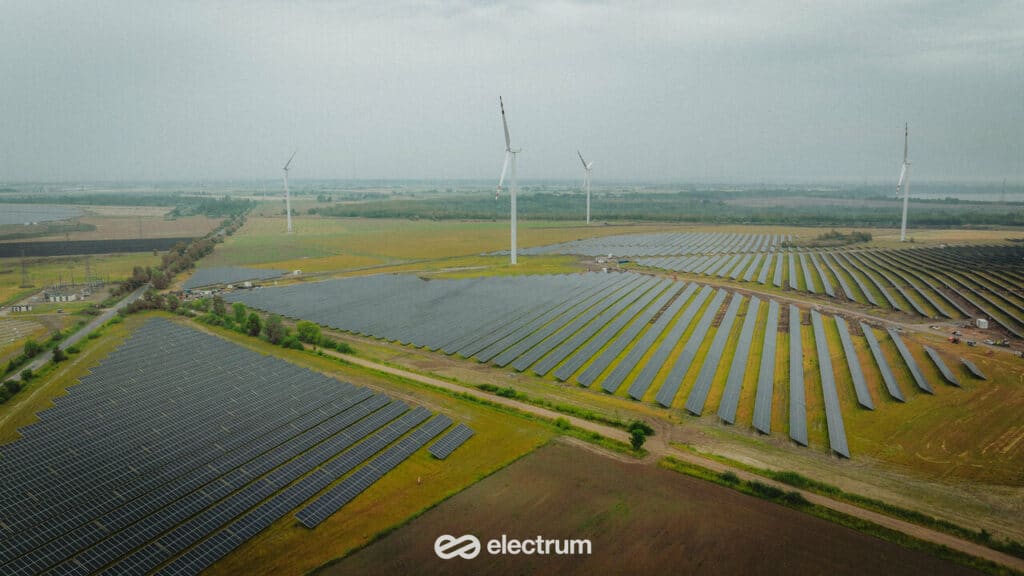
An energy storage system is also planned for Kleczew. How will energy storage impact the installation?
Introducing energy storage will allow us to overcome the current limitations imposed on the farm. The photovoltaic farm in Kleczew has a capacity of 250 MWp, of which we can effectively use 193 MW. A similar situation applies to the wind farm – out of four turbines with a capacity of 4.8 MW each, we can effectively use only 11.7 MW. These limitations result from the connection agreement. The facility can continue to be expanded. Currently, we have 204 MW of connection capacity, and we are ready to continuously transmit 240 MW to PSE.
Energy storage will allow excess energy that currently cannot be transmitted to the grid due to contractual limitations to be stored. In practice, this means that surplus energy that cannot be directly utilized will be stored. In moments when energy production from solar and wind is lower, the energy storage system will be able to release the stored energy to the grid. This will allow for more consistent energy delivery to the grid, avoiding sudden drops and spikes in power.
Energy storage will enable more efficient management of the farm’s energy production. Solar energy is produced mainly from late morning to early afternoon, after which it decreases. Wind energy production, on the other hand, can be more variable. Energy storage will smooth out these fluctuations, allowing energy to be delivered to the grid in a more stable and consistent manner.
Introducing energy storage also opens up possibilities for further expansion of the farm. With energy storage, we can increase the installation’s capacity. Excess energy can be stored and used during times of higher demand. For example, if we have 204 MW of connection capacity, the storage system will allow us to maintain maximum power for longer periods under ideal conditions at midday when energy production is highest.

Are hybrid renewable energy systems the future of renewable energy? Is this the direction in which renewable energy will expand more broadly?
It is certainly one of the directions. It all comes down to making these energy sources as flexible and efficient as possible. The demand for energy from the grid is not uniform. There are hours when energy is needed more, and others when it is needed less. The broader application of hybrid farms, additionally with energy storage, will allow for better alignment with demand.
Another related issue is the distribution network in Poland. We have problems with energy transmission. On weekends, there is usually too much energy. That’s the situation we have. The operator does not want to receive this energy on weekends and signals to shut down or limit production from the farm. In the worst case, penalties and negative energy prices may appear during this time. If we have a hybrid renewable energy systems with energy storage, we can adapt our production to the conditions – shut down or reduce the power of the photovoltaic installation while the wind farm continues to operate.
The hybrid power plants can also operate entirely independently of the grid. With energy storage, we can store energy and utilize it according to our needs without relying on the grid operator.
In the long run, we can expect hybrid power plants to become more widespread. Investors and operators will increasingly rely on these advanced energy solutions. Hybrid systems can provide more flexible and efficient energy production, especially with energy storage, and become an important part of Poland’s energy mix.
If you have any further questions, feel free to contact us.
Hybrid renewable energy systems – An Interview with Kamil Kozicki
Another Innovative Project Completed by Electrum – PV Kotuń with Solar Tracker Technology
Another Innovative Project Completed by Electrum – PV Kotuń with Solar Tracker Technology
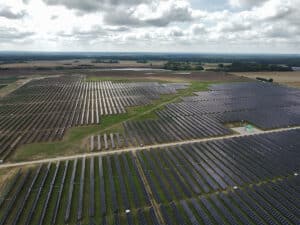
PV Kotuń Power Plant consists of five smaller photovoltaic facilities, each with a capacity of 10MW, totaling 50MW of clean energy. The installation covers an area of approximately 76 hectares and is capable of powering 26,840 households, while simultaneously reducing CO2 emissions by 43,611 tons annually.
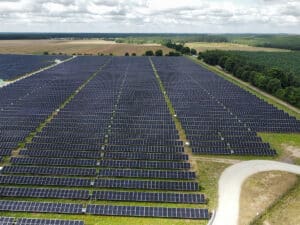
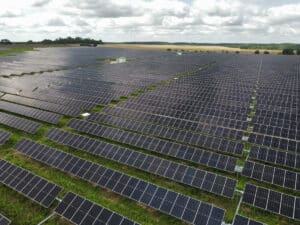
50MW of low-emission energy is generated by 87,000 bifacial photovoltaic panels utilizing solar tracker technology. These innovative trackers allow the PV panels to follow the movement of the sun, maximizing energy production throughout the day. This technology, applied for the first time in Poland on a project of this scale, significantly increases the installation’s efficiency compared to static structures.
The farm was energized in February this year. It was connected to the distribution network using 5 medium-voltage lines of 15 kV – with a total length of approximately 10 km.
Read also: Solar farm construction
Another Innovative Project Completed by Electrum – PV Kotuń with Solar Tracker Technology
Lipno Solar Park: One of the Largest Photovoltaic Farms in Poland Built by Electrum
Lipno Solar Park: One of the Largest Photovoltaic Farms in Poland Built by Electrum
We are proud to announce the commissioning of one of the largest photovoltaic farms in Poland, built by the Electrum Group, in Lipno. The project investor is Wento.
Wento is one of the largest renewable energy developers in Poland. They are involved in developing, building, and operating photovoltaic and wind projects across the country. Present on the Polish market since 2011, the company has been part of the international Equinor (formerly Statoil) group, one of the largest players in the global energy market, since 2021.
Located in Greater Poland, Lipno Solar Park is an impressive power plant with a capacity of 53 MW, contributing to the development of renewable energy in Poland. The farm consists of nearly one hundred thousand solar panels, covering an area of over 80 hectares. The entire investment will be able to produce 58 GWh of energy annually, equivalent to the consumption of 29,000 households.
Thanks to the expertise and experience of Electrum experts, the project was realized in a way that maximized the facility’s potential. The construction took less than two years and was carried out simultaneously in three locations. Additionally, accompanying infrastructure was also built, including a medium voltage power station and an overhead high voltage switchyard. Over 600 kilometers of cables were laid, and 212 inverters and 8 medium voltage stations were installed.
The general contractor for the Lipno solar power plant is Electrum Concreo, working with the contract engineer – J.S. Hamilton Poland, while safety and health supervision was provided by Human BHP.
The investment will also benefit the local community – the Lipno municipality will receive tax revenues.
Lipno Solar Park: One of the Largest Photovoltaic Farms in Poland Built by Electrum
Can Music Be Green? How the Electrum Up To Date Festival 2024 Brings Ecology to the Music Scene
Can Music Be Green? How the Electrum Up To Date Festival 2024 Brings Ecology to the Music Scene
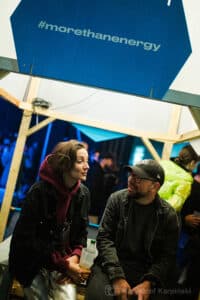
The first edition of the Electrum Up To Date Festival is behind us. It’s not the first Up To Date in general, but the first one where we are the title sponsor. We decided to strengthen the cooperation that has been ongoing for two years with this significant event, not only in our opinion. Just as it plays the role of an active creator of culture in Białystok, with our help, it could fulfill the role of a model in the area of sustainable event organization.
Together with the organizers, we designed a series of actions through which this well-known event in Poland and Europe sets a great example of how to show respect and help our planet. From a conference where reflection went hand in hand with active exchange of ideas, to abandoning the production of new festival clothing, to using the services and work of local suppliers.
Together we can do more. But this motto only works if we truly collaborate. In the case of Electrum and the Up To Date Festival, it resulted in cooperation we are proud of. See what we’ve done:
Ecological Awareness as the Foundation of a Sustainable Future
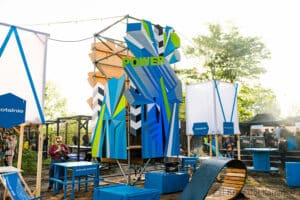
The first stop on the road to a more sustainable future is the awareness of how to act in a way that contributes as little as possible to the deterioration of the planet’s condition. The best are, of course, zero or positive impact. However, producing an event is not easy to achieve. This doesn’t mean we don’t try! And when we try, we are transparent and honest in our communication. This year, the Electrum Up To Date social media profiles and the event’s website were even better than last year in providing current information about actions, motivations, and important ideas. We are growing.
We promoted respect for the planet, respect for others, and respect for oneself. These are inseparable components in the discussion about a healthy approach to participating in the world.
To strengthen this discussion, we organized the second edition of the “Do We Really Care?” conference. It included four festival discussion panels addressing topics we managed to signal last year: pro-ecological action in the cultural sector, mental health, the condition of the electronic music scene, and actions for culture in the wartime reality. Together with a series of guests invited to the panels, we asked questions about effective joint creation of changes and outlined the challenges ahead of us.
At Electrum, we particularly know that real change is preceded by conversations where the exchange of ideas and mutual inspiration play a key role. This was also the essence of our cooperation and the introduction of effective actions for a green future.
Reducing Carbon Emissions by Choosing Local Suppliers and Emphasizing Low-Emission Transport

Regarding the gastronomic offer available at the festival, we focused on local producers and suppliers, thereby reducing the transport costs of individual products and the people behind their preparation and service. We chose subcontractors from our region, even in the face of more attractive prices from other regions. In doing so, we want not only to reduce our emissions but also to promote local offers and local cooperation.
We know that cheaper offers often tempt event organizers (and not only them) with limited budgets. There is nothing strange about that; however, when funds are available, we believe it is worth spending them on local cooperation. At the Electrum Up To Date Festival, our role as the title sponsor played a significant role. We invested funds to help a local event, knowing they would be used well and in line with our shared values.
We want to set an example for other entities with greater capabilities and emphasize that investment in local independent culture is much more than just the promotion behind the name change on the posters.
To reduce emissions, though not necessarily the cost of transport for individual artists, we focused on artists on tour, those from nearby European countries, and local names. Many of them used trains to come to Białystok.
We tried to limit air travel to the necessary minimum (e.g., a flight from the UK). Even in the case of choosing a flight, we combined it with arriving in Warsaw and then traveling by train or a special bus to Białystok. Choosing public transport over a flight is an important element of the sustainable chain that helped build this year’s edition of the festival. Festival participants were also encouraged to use public transport, as well as to come to the festival in groups (we had group tickets for sale). This built not only an ecological spirit but also a community.
Additionally, we provided more places for cyclists who chose this mode of transport to get to the festival, the most ecological of all. As for cars, we strongly encouraged drivers to travel in larger groups.
Reducing Waste by Abandoning New Festival Clothing, Emphasizing Reusable Products, and Building Festival Scenery Based on the Circular Economy
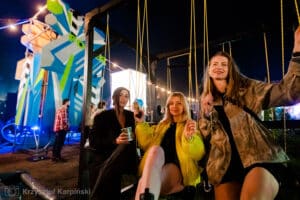
Knowing that we want to introduce as little waste into the world as possible, we once again decided to abandon new festival clothing, so-called merch. For the team behind the festival, this was not an easy decision from the beginning – mainly due to the promotion of the brand and high revenue from the sale of such clothing. But the alternative has many advantages. This year’s collection of festival clothing was once again based on second-hand clothes, which meant that so-called fashion gems and unique items were available. Additionally, we offered the opportunity to enhance one’s own clothing with festival prints. This is our way of inspiring actions in line with the circular economy.
The same idea guided the process of creating the scenery – we focused on reusing often forgotten objects and materials. Clothes and decorations brought to life in this way carry undeniable uniqueness.
To reduce the environmental impact of our activities, we chose a local producer and supplier of water in returnable glass bottles. Still water was available in dispensers for those with their own reusable bottles. At Electrum, we encourage the daily choice of such bottles. This year, you could enter any festival area with them. Water available at the bar was for sale at an attractive price of 5 PLN (a little over 1 euro). We know that affordable prices of basic goods are a necessity to create a safe space.
For many suppliers from the gastronomic and bar area, we managed to rely on reusable cups or biodegradable or paper packaging (cups, bowls, plates, cutlery).
Not all partners agreed to such solutions, but we are on the right path to achieving 100% packaging without single-use plastic in the future. Change doesn’t happen suddenly. It’s a whole path, sometimes a labyrinth of actions that need to be consistently implemented to achieve the goal.
Last but Not Least: Promoting Locality and the Region
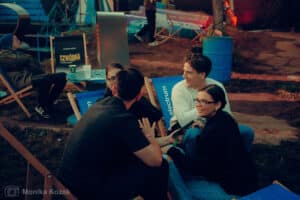
We already mentioned cooperation with local suppliers and artists, but focusing on locality is a key element in the discussion about the planet’s better condition, so we want to emphasize it again at the end. Using local goods and staying in your region or country as often as possible, including traveling by public transport, is the most effective form of helping the planet. However, we know that for such a form to be possible, among other things, the availability and attractiveness of local products, services, and culture are necessary.
From the beginning, the festival aimed to promote Podlasie as a region worth exploring. Its charms were discovered not only by visitors but also by so-called locals, people who have lived in Białystok for years. This year’s Electrum Up To Date Festival took place at the Białystok Puppet Theater, Arsenal Gallery, Branicki Palace’s power plant, and in an industrial outdoor area forgotten by the local community. The initially heavily devastated city-owned area provided an urban charm to the festival experience and worked well with the festival’s artistic program. This is an example of how available areas within our local reach can be used when organizing events.
Can Music Be Green?
Overall, the Electrum Up To Date Festival is an admirable example of how to reduce the negative environmental impact while organizing a music event. We can proudly say that this year’s first edition of the festival with Electrum as the title sponsor, but already the 15th anniversary edition overall, proved that music and ecology can go hand in hand. Thanks to the joint efforts of Electrum and the festival team, we have created an event that not only provides world-class musical experiences but also serves as a model of ecological responsibility. Our actions for awareness, emission reduction, waste limitation, and promoting locality show that in the world of entertainment, we can and must strive for sustainable development. We believe that such initiatives can inspire others to take similar steps, leading us all toward a better, greener future.
_____________________
More about the Electrum Group can be found on our social media channels at LinkedIn, Facebooku and Instagramie.
Press contact
| Jan Roguz
Electrum Adapt tel. +48 539 732 610 |
Magdalena Myczko
Havas PR tel. +48 508 012 198 |


